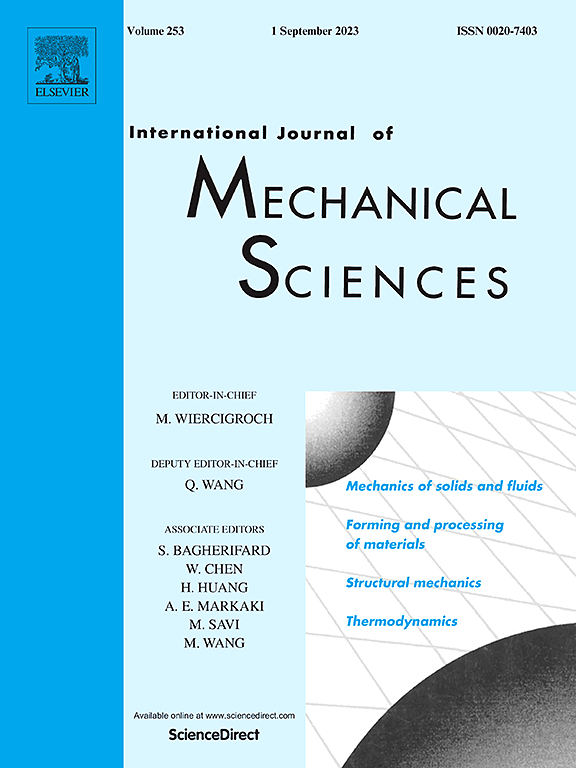Elimination of electrode corrugations via a two-step calendering process
IF 7.1
1区 工程技术
Q1 ENGINEERING, MECHANICAL
International Journal of Mechanical Sciences
Pub Date : 2025-06-23
DOI:10.1016/j.ijmecsci.2025.110525
引用次数: 0
Abstract
Calendering is a crucial process in the manufacturing of lithium-ion batteries electrodes. Corrugations occur frequently in the electrode during calendering, leading to challenges in large-scale and low-cost production of lithium-ion batteries in industry. An in-depth understanding of the formation mechanism of electrode corrugations during calendering process is essential to improve the process and eliminate the corrugations. To do so, compression and tension experiments were first performed to obtain the mechanical properties of the porous active material for electrodes. The Drucker-Prager Cap (DPC) model was calibrated based on experimental results, and employed to capture the plastic deformation of the active material in the calendering process. The current collector foil was revealed to be responsible for the formation of corrugations, which hindered the elongation of the calendered active material. Based on the elongation difference obtained, a novel two-step process introducing a pre-elongation step was proposed. In the pre-elongation step, the rolling pressure was determined by simulation to elongate the foil by 0.75 %, enabling the elongation of the foil to match that of the active material in the next step. By using this new process, the corrugations of the calendered electrodes were significantly suppressed without requiring large web tensions. The intensity of the corrugations was reduced by >60 %, which is of great significance to reduce the calendered electrode defects, scrap rates, and manufacturing costs of lithium-ion batteries.

通过两步压延工艺消除电极波纹
压延是制造锂离子电池电极的关键工艺。在压延过程中,锂离子电池电极经常发生波纹,这给锂离子电池的大规模低成本生产带来了挑战。深入了解压延过程中电极波纹的形成机理,对改进压延工艺、消除压延过程中电极波纹的产生具有重要意义。为此,首先进行了压缩和拉伸实验,以获得多孔电极活性材料的力学性能。基于实验结果对Drucker-Prager Cap (DPC)模型进行了标定,并利用DPC模型捕捉了活性材料在压延过程中的塑性变形。电流集电极箔是负责波纹的形成,这阻碍了延伸性的压延活性材料。基于得到的伸长率差,提出了一种引入预伸长率步骤的两步法。在预延伸阶段,通过模拟确定轧制压力,使箔的延伸率达到0.75%,使箔的延伸率与下一阶段活性材料的延伸率相匹配。通过使用这种新工艺,压延电极的波纹被显著抑制,而不需要大的腹板张力。波纹强度降低了60%,这对减少压延电极的缺陷、废品率、降低锂离子电池的制造成本具有重要意义。
本文章由计算机程序翻译,如有差异,请以英文原文为准。
求助全文
约1分钟内获得全文
求助全文
来源期刊

International Journal of Mechanical Sciences
工程技术-工程:机械
CiteScore
12.80
自引率
17.80%
发文量
769
审稿时长
19 days
期刊介绍:
The International Journal of Mechanical Sciences (IJMS) serves as a global platform for the publication and dissemination of original research that contributes to a deeper scientific understanding of the fundamental disciplines within mechanical, civil, and material engineering.
The primary focus of IJMS is to showcase innovative and ground-breaking work that utilizes analytical and computational modeling techniques, such as Finite Element Method (FEM), Boundary Element Method (BEM), and mesh-free methods, among others. These modeling methods are applied to diverse fields including rigid-body mechanics (e.g., dynamics, vibration, stability), structural mechanics, metal forming, advanced materials (e.g., metals, composites, cellular, smart) behavior and applications, impact mechanics, strain localization, and other nonlinear effects (e.g., large deflections, plasticity, fracture).
Additionally, IJMS covers the realms of fluid mechanics (both external and internal flows), tribology, thermodynamics, and materials processing. These subjects collectively form the core of the journal's content.
In summary, IJMS provides a prestigious platform for researchers to present their original contributions, shedding light on analytical and computational modeling methods in various areas of mechanical engineering, as well as exploring the behavior and application of advanced materials, fluid mechanics, thermodynamics, and materials processing.
 求助内容:
求助内容: 应助结果提醒方式:
应助结果提醒方式:


